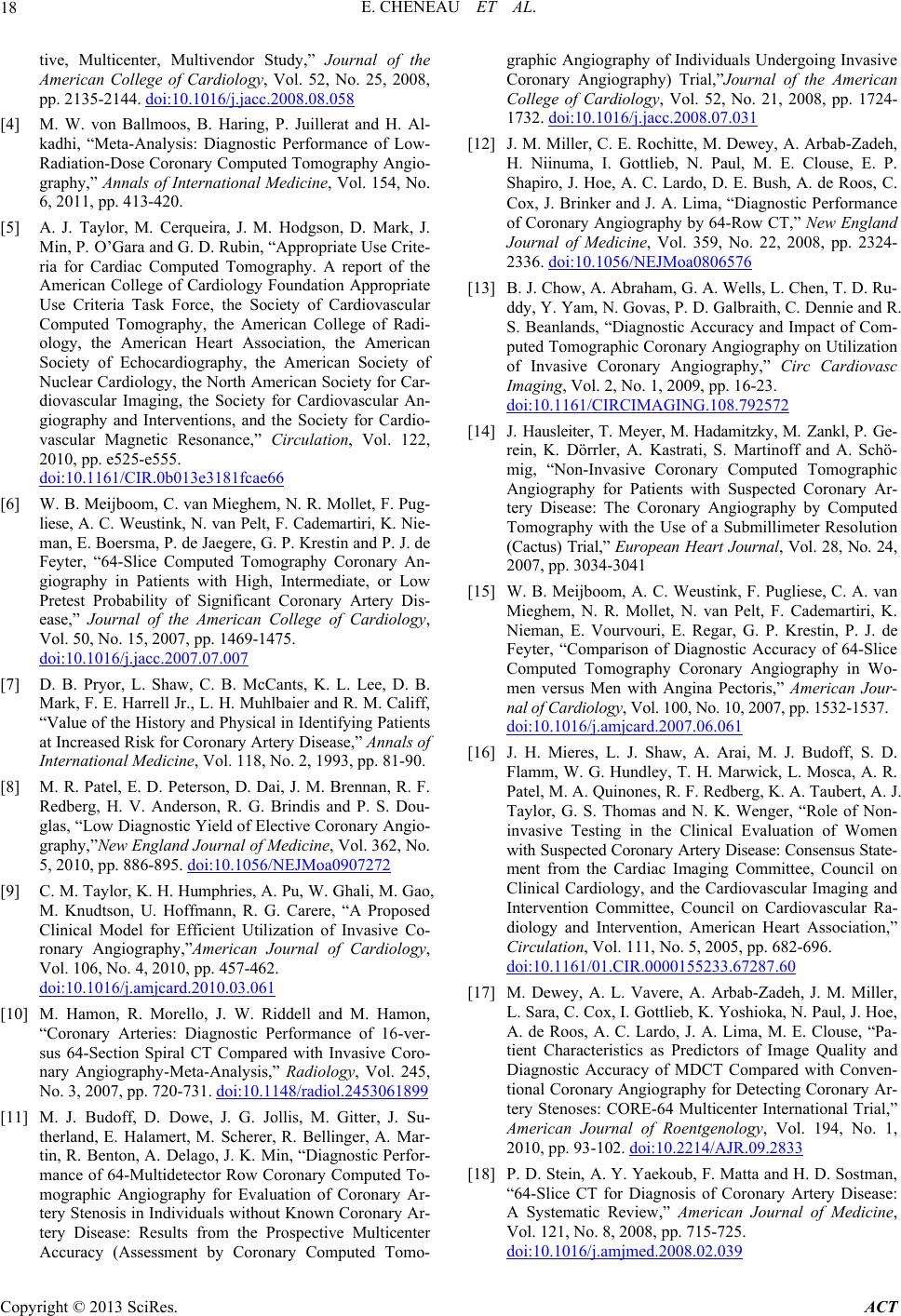
E. CHENEAU ET AL.
18
tive, Multicenter, Multivendor Study,” Journal of the
American College of Cardiology, Vol. 52, No. 25, 2008,
pp. 2135-2144. doi:10.1016/j.jacc.2008.08.058
[4] M. W. von Ballmoos, B. Haring, P. Juillerat and H. Al-
kadhi, “Meta-Analysis: Diagnostic Performance of Low-
Radiation-Dose Coronary Computed Tomography Angio-
graphy,” Annals of International Medicine, Vol. 154, No.
6, 2011, pp. 413-420.
[5] A. J. Taylor, M. Cerqueira, J. M. Hodgson, D. Mark, J.
Min, P. O’Gara and G. D. Rubin, “Appropriate Use Crite-
ria for Cardiac Computed Tomography. A report of the
American College of Cardiology Foundation Appropriate
Use Criteria Task Force, the Society of Cardiovascular
Computed Tomography, the American College of Radi-
ology, the American Heart Association, the American
Society of Echocardiography, the American Society of
Nuclear Cardiology, the North American Society for Car-
diovascular Imaging, the Society for Cardiovascular An-
giography and Interventions, and the Society for Cardio-
vascular Magnetic Resonance,” Circulation, Vol. 122,
2010, pp. e525-e555.
doi:10.1161/CIR.0b013e3181fcae66
[6] W. B. Meijboom, C. van Mieghem, N. R. Mollet, F. Pug-
liese, A. C. Weustink, N. van Pelt, F. Cademartiri, K. Nie-
man, E. Boersma, P. de Jaegere, G. P. Krestin and P. J. de
Feyter, “64-Slice Computed Tomography Coronary An-
giography in Patients with High, Intermediate, or Low
Pretest Probability of Significant Coronary Artery Dis-
ease,” Journal of the American College of Cardiology,
Vol. 50, No. 15, 2007, pp. 1469-1475.
doi:10.1016/j.jacc.2007.07.007
[7] D. B. Pryor, L. Shaw, C. B. McCants, K. L. Lee, D. B.
Mark, F. E. Harrell Jr., L. H. Muhlbaier and R. M. Califf,
“Value of the History and Physical in Identifying Patients
at Increased Risk for Coronary Artery Disease,” Annals of
International Medicine, Vol. 118, No. 2, 1993, pp. 81-90.
[8] M. R. Patel, E. D. Peterson, D. Dai, J. M. Brennan, R. F.
Redberg, H. V. Anderson, R. G. Brindis and P. S. Dou-
glas, “Low Diagnostic Yield of Elective Coronary Angio-
graphy,”New England Journal of Medicine, Vol. 362, No.
5, 2010, pp. 886-895. doi:10.1056/NEJMoa0907272
[9] C. M. Taylor, K. H. Humphries, A. Pu, W. Ghali, M. Gao,
M. Knudtson, U. Hoffmann, R. G. Carere, “A Proposed
Clinical Model for Efficient Utilization of Invasive Co-
ronary Angiography,”American Journal of Cardiology,
Vol. 106, No. 4, 2010, pp. 457-462.
doi:10.1016/j.amjcard.2010.03.061
[10] M. Hamon, R. Morello, J. W. Riddell and M. Hamon,
“Coronary Arteries: Diagnostic Performance of 16-ver-
sus 64-Section Spiral CT Compared with Invasive Coro-
nary Angiography-Meta-Analysis,” Radiology, Vol. 245,
No. 3, 2007, pp. 720-731. doi:10.1148/radiol.2453061899
[11] M. J. Budoff, D. Dowe, J. G. Jollis, M. Gitter, J. Su-
therland, E. Halamert, M. Scherer, R. Bellinger, A. Mar-
tin, R. Benton, A. Delago, J. K. Min, “Diagnostic Perfor-
mance of 64-Multidetector Row Coronary Computed To-
mographic Angiography for Evaluation of Coronary Ar-
tery Stenosis in Individuals without Known Coronary Ar-
tery Disease: Results from the Prospective Multicenter
Accuracy (Assessment by Coronary Computed Tomo-
graphic Angiography of Individuals Undergoing Invasive
Coronary Angiography) Trial,”Journal of the American
College of Cardiology, Vol. 52, No. 21, 2008, pp. 1724-
1732. doi:10.1016/j.jacc.2008.07.031
[12] J. M. Miller, C. E. Rochitte, M. Dewey, A. Arbab-Zadeh,
H. Niinuma, I. Gottlieb, N. Paul, M. E. Clouse, E. P.
Shapiro, J. Hoe, A. C. Lardo, D. E. Bush, A. de Roos, C.
Cox, J. Brinker and J. A. Lima, “Diagnostic Performance
of Coronary Angiography by 64-Row CT,” New England
Journal of Medicine, Vol. 359, No. 22, 2008, pp. 2324-
2336. doi:10.1056/NEJMoa0806576
[13] B. J. Chow, A. Abraham, G. A. Wells, L. Chen, T. D. Ru-
ddy, Y. Yam, N. Govas, P. D. Galbraith, C. Dennie and R.
S. Beanlands, “Diagnostic Accuracy and Impact of Com-
puted Tomographic Coronary Angiography on Utilization
of Invasive Coronary Angiography,” Circ Cardiovasc
Imaging, Vol. 2, No. 1, 2009, pp. 16-23.
doi:10.1161/CIRCIMAGING.108.792572
[14] J. Hausleiter, T. Meyer, M. Hadamitzky, M. Zankl, P. Ge-
rein, K. Dörrler, A. Kastrati, S. Martinoff and A. Schö-
mig, “Non-Invasive Coronary Computed Tomographic
Angiography for Patients with Suspected Coronary Ar-
tery Disease: The Coronary Angiography by Computed
Tomography with the Use of a Submillimeter Resolution
(Cactus) Trial,” European Heart Journal, Vol. 28, No. 24,
2007, pp. 3034-3041
[15] W. B. Meijboom, A. C. Weustink, F. Pugliese, C. A. van
Mieghem, N. R. Mollet, N. van Pelt, F. Cademartiri, K.
Nieman, E. Vourvouri, E. Regar, G. P. Krestin, P. J. de
Feyter, “Comparison of Diagnostic Accuracy of 64-Slice
Computed Tomography Coronary Angiography in Wo-
men versus Men with Angina Pectoris,” American Jour-
nal of Cardiology, Vol. 100, No. 10, 2007, pp. 1532-1537.
doi:10.1016/j.amjcard.2007.06.061
[16] J. H. Mieres, L. J. Shaw, A. Arai, M. J. Budoff, S. D.
Flamm, W. G. Hundley, T. H. Marwick, L. Mosca, A. R.
Patel, M. A. Quinones, R. F. Redberg, K. A. Taubert, A. J.
Taylor, G. S. Thomas and N. K. Wenger, “Role of Non-
invasive Testing in the Clinical Evaluation of Women
with Suspected Coronary Artery Disease: Consensus State-
ment from the Cardiac Imaging Committee, Council on
Clinical Cardiology, and the Cardiovascular Imaging and
Intervention Committee, Council on Cardiovascular Ra-
diology and Intervention, American Heart Association,”
Circulation, Vol. 111, No. 5, 2005, pp. 682-696.
doi:10.1161/01.CIR.0000155233.67287.60
[17] M. Dewey, A. L. Vavere, A. Arbab-Zadeh, J. M. Miller,
L. Sara, C. Cox, I. Gottlieb, K. Yoshioka, N. Paul, J. Hoe,
A. de Roos, A. C. Lardo, J. A. Lima, M. E. Clouse, “Pa-
tient Characteristics as Predictors of Image Quality and
Diagnostic Accuracy of MDCT Compared with Conven-
tional Coronary Angiography for Detecting Coronary Ar-
tery Stenoses: CORE-64 Multicenter International Trial,”
American Journal of Roentgenology, Vol. 194, No. 1,
2010, pp. 93-102. doi:10.2214/AJR.09.2833
[18] P. D. Stein, A. Y. Yaekoub, F. Matta and H. D. Sostman,
“64-Slice CT for Diagnosis of Coronary Artery Disease:
A Systematic Review,” American Journal of Medicine,
Vol. 121, No. 8, 2008, pp. 715-725.
doi:10.1016/j.amjmed.2008.02.039
Copyright © 2013 SciRes. ACT